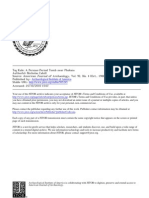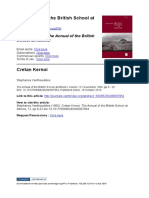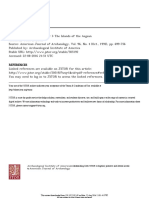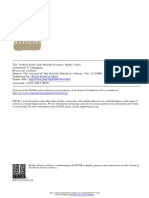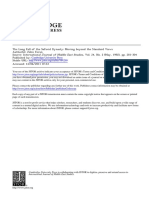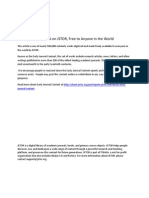Tepe Abdul Hosein A Neolithic Site in Western Iran Excavations 1978
Tepe Abdul Hosein A Neolithic Site in Western Iran Excavations 1978
Uploaded by
ahmad13601360Copyright:
Available Formats
Tepe Abdul Hosein A Neolithic Site in Western Iran Excavations 1978
Tepe Abdul Hosein A Neolithic Site in Western Iran Excavations 1978
Uploaded by
ahmad13601360Original Description:
Original Title
Copyright
Available Formats
Share this document
Did you find this document useful?
Is this content inappropriate?
Copyright:
Available Formats
Tepe Abdul Hosein A Neolithic Site in Western Iran Excavations 1978
Tepe Abdul Hosein A Neolithic Site in Western Iran Excavations 1978
Uploaded by
ahmad13601360Copyright:
Available Formats
Tepe Abdul Hosein: A Neolithic Site in Western Iran Excavations 1978 by Judith Pullar
Review by: Abbas Alizadeh
Journal of Near Eastern Studies, Vol. 57, No. 2 (Apr., 1998), pp. 146-148
Published by: The University of Chicago Press
Stable URL: http://www.jstor.org/stable/546289 .
Accessed: 25/01/2013 04:55
Your use of the JSTOR archive indicates your acceptance of the Terms & Conditions of Use, available at .
http://www.jstor.org/page/info/about/policies/terms.jsp
.
JSTOR is a not-for-profit service that helps scholars, researchers, and students discover, use, and build upon a wide range of
content in a trusted digital archive. We use information technology and tools to increase productivity and facilitate new forms
of scholarship. For more information about JSTOR, please contact support@jstor.org.
The University of Chicago Press is collaborating with JSTOR to digitize, preserve and extend access to Journal
of Near Eastern Studies.
http://www.jstor.org
This content downloaded on Fri, 25 Jan 2013 04:55:56 AM
All use subject to JSTOR Terms and Conditions
146 JOURNALOF NEAR EASTERNSTUDIES VOL. 57 No. 2
Chap. 5 treats separately those pieces for scholarship) and while the bibliographycontains
which a Minoan origin has been demonstrated several publications not actually cited in the text
or suggested. The format emulates that estab- or footnotes of the book itself, on the whole, this
lished in chap. 2, so that the entries are arranged volume is tremendously useful and can be rec-
according to vessel shape, with a brief descrip- ommended without reserve. It will be a welcome
tion and discussion of each, albeit sans illustra- addition to the bookshelf of every archaeologist
tion, followed by a separate series of catalogue specializing in the Bronze Age of either the
entries listing the findspots of each example Aegean or the EasternMediterraneanand will be
known from Syria-Palestine. of particularinterest to those attemptingto doc-
Chap. 6 contains a site index, in which the ument the trade between those two regions. It
sites in Syria-Palestine at which Aegean vessels will also join the works of Furumark,French,
and figurines have been found are listed in al- and Mountjoy at every ongoing archaeological
phabetic order, with an abbreviated record re- excavation in Egypt and the Near East which
iterating the shapes present at that site and the touches upon Late Bronze Age levels, for it is an
catalogue numbersassigned to each. As Leonard essential volume of description, discussion, and
notes, the catalogue and indexes in the various comparanda which will serve to augment the
chapters can be used either individually or in scarce resources available for identifying the
concert with one or more of the others. often-fragmentary Aegean sherds recovered at
Following these chaptersare three appendixes. such Eastern Mediterraneansites. As such, an
Appendix A lists the specific chariotcomponents added, perhapsunintentional,benefit stems from
representedin the chariot scenes on Mycenaean the fact that the volume has been printed as a
vases from Syria-Palestine, while Appendix B hardbackbook with sewn binding; thus, its man-
lists the incised signs and Appendix C the ufacture guarantees that the volume will stand
painted signs found on the Aegean pottery from up to years of well-thumbeduse and will survive
Syria-Palestine. the rigors of being taken into the field season
Finally, following an extremely useful bib- after season.
liography, some thirty-eight distribution maps
graphically depict the findspots of the Aegean ERIC H. CLINE
pottery in Syria-Palestine, arranged according
to vessel shape. For example, map 11 depicts Universityof Cincinnati
the distributionof Mycenaean "GlobularStirrup
Jars"(FS 171 and 173) found in Syria-Palestine,
while map 23 charts the findspots of Mycenaean
"Conical and Ostrich Egg Rhyta" (FS 199 and TepeAbdul Hosein: A Neolithic Site in Western
201) found in Syria-Palestine. Iran Excavations 1978. By JUDITHPULLARET
Within the chapters and individual entries AL.B.A.R. InternationalSeries 563. London:
themselves, Leonardis authoritative;yet he takes B.A.R., 1990. Pp. 259 + 77 figs. + 24 pls.
care to present alternateviews and/or to explain This book is an excellent example of what can
the various problems involved. The numerous be achieved with a modest budget and during a
drawings of shapes and motifs accompanying short, but careful, season. It is also an exemplary
the text and catalogue are extremely useful. Al- way of organizing and presentingexcavated ma-
though one misses the presence of plates, ample terials. In chap. 2, for example, the excavator
references are given to those which may be leaves nothing to the reader's imagination. The
found in Furumarkand elsewhere. Overall, the archaeological units and levels are well defined,
text, catalogue, and illustrations clearly reflect the techniques described, and the rationale for
Leonard's painstaking labor of more than two each operation explained. This gives the reader
decades. an excellent opportunity to ascertain the weak-
While there are a number of superficial typo- ness and strengthof the projectand to appreciate
graphical errors (which do not greatly affect the the conditions underwhich the excavations were
This content downloaded on Fri, 25 Jan 2013 04:55:56 AM
All use subject to JSTOR Terms and Conditions
APRIL 1998 BOOK REVIEWS 147
carried out. Moreover, the report is generously seems to be a break in the occupationallevels of
supported by numerous meticulously prepared the aceramicand ceramic phases, separatedby "a
section drawings, plans, and charts. All the ob- hard crust of dark brown or black clay mixed
jects found on floors are triangulated,numbered, with small stones" (p. 6). The 1 m of occupa-
and described in a separate page facing the il- tional debris above this deposit was too disturbed
lustrations (e.g., pp. 42-43, fig. 13). The spatial to yield any tracesof solid architecture,but traces
distributionpatternson the surfaces and floors of of walls are noted in sections (p. 10). It seems
artifacts and ecofacts are painstakingly provided that the site as a village was deserted by the mid-
with facing charts, describing each item. The seventh millennium and was consequently cov-
same is done for the burials and their contents. ered with mixture of colluvium and alluvium.
The book is a report on the excavations at The pottery (pp. 157-61) is primarilycoarse,
Tappeh Abdul Hosein, a small early Neolithic plain, and handmade;the surface is usually buff.
site, ca. 6 m high and 50 m in diameter. At an Insofar as the shapes can be reconstructed,they
elevation of 1860 m, the mound is located in are simple with thick, flat bases. Mineraland veg-
the valley of Ab-e Qeshlaq, halfway between the etal temperingagents were used either separately
modern towns of Khurramabadand Malayer, in or in combination, with the latter being most
the central Zagros mountains. The excavation of frequent. Some sherds are burnished, but since
the mound was intended to test a number of most of the sherds have an eroded surface or
hypotheses concerning the crucial period of tran- are covered with incrustation, burnishing may
sition from hunting-gatheringto early domestica- have been more common. The painted pottery is
tion of plants and animals and the environmental scanty, and one piece is identified as "J" ware,
conditions during the early Neolithic period presumablycontemporarywith the Halaf period
(p. 8). in northern Mesopotamia. Only a handful of
Temporary camps or campsites of the late painted pottery was found (23 lip-sherds and 46
Pleistocene hunting-gatheringpopulation of the body-sherds, little over 0.3 percent of the total).
Zagros mountains are representedby such sites These sherds of mixed painted pottery,dating to
as Karim Shahir, Zawi Chemi, Shanidar B-l, the sixth and fifth millennia, were discovered
MoDlafaatand Gerd Chai, Ganj Darreh E, and in the upper disturbed levels (p. 10). Almost all
Asiab. Initial village life, though not necessarily of the painted examples exhibit characteristics
permanent,is representedin the Zagros by sites of early Neolithic pottery. The presence of later
such as Tappeh Guran and Tappeh Sarab. A ceramic, perhaps as late as Late Middle Susiana
number of 14C dates put the earliest occupation (fig. 62:11), indicates that the site must have
of Tappeh Abdul Hosein in the early seventh been used as a campsite after it was abandoned
millennium B.C., i.e., the end of Ganj Darreh, as a village.
and before the beginning of Tappeh Guran and Clay figurines,spindlewhorls, andtokens were
TappehSarab. found in most levels (pp. 169-72). Also bone
The deposits are divided into aceramic and tools, stone bowl fragments, pounders, pestles,
ceramic phases, each with a number of associ- and grinders, all common components of early
ated levels. The earliest occupation seems to be Neolithic sites occur (p. 10). Stone tools were
a seasonal campsite with no solid architecture. found in all levels and resembled the lithic tech-
This phase is characterizedby having a number nology at Ganj Darreh and Asiab (pp. 213-16).
of cooking and storing installations(p. 9). Some- Sixteen pieces of obsidian were found from all
what later,tracesof rectangular,mud-brickarchi- levels, except in the campsite phase (pp. 12, 113).
tecture with mud-plasteredfloors, some painted Eleven pieces of the NemrutDagh obsidian seem
red, occur (p. 9). Cultivated wheat and barley to be the earliest occurrence of this commodity
were presentfrom the beginning, aceramic phase in the Zagros mountains (pp. 6, 12, 113). The
(p. 5). But except for a number of surfaces and lack of obsidian at Ganj Darreh, its presence at
floors (some mud-plastered),no traces of solid Abdul Hosein, and its abundance at Guran and
architecturewere found in this phase (p. 6). There Sarab also draw attentionto the transitorynature
This content downloaded on Fri, 25 Jan 2013 04:55:56 AM
All use subject to JSTOR Terms and Conditions
148 JOURNAL
OF NEAREASTERNSTUDIES VOL. 57 No. 2
of the site between Ganj Darreh and Sarab and and language, limited themselves to translating
Guran. from previous French,English, or Germantrans-
Although the bones were not available for lations, Only the Hittite version of the poem was
analysis, worked bones were used to identify the put directly into Spanish (A. Bernab6, Textos
presence at the site of some domesticates such as Literarios Hetitas [Madrid, 1979 and 19871, pp.
sheep/goat, deer, boar, and wolf/leopard (pp. 10, 93-115).
189-91). It is unfortunatethat the faunal mate- The translatorhas aimed his work at the lay-
rial has not been analyzed due to the political man, at a readerwith an interest mainly either in
turmoil in Iran (p. 6). This hampers any conclu- ancient poetry, or in Mesopotamianculture, or in
sions on the state of animal husbandryat the site, both. In order to offer a continuous and coherent
crucial to the natureof the transitionperiod. text, Silva Castillo resorts to the Old Babylonian
Two-row hulled barley (Hardeum distichon), version to complete the StandardVersionin some
emmer (Triticium dicoccum), and lentils (Lens cases. Moreover, to save the reader from the
culinare) were identified. Pistachio nuts and philological selva selvaggia of differentkinds of
almond stones were also present (pp. 217-20). brackets, but giving, at the same time, an accu-
Hubbard (pp. 217-22) argues that agriculture rate idea of the state of the text, he uses italics
was brought to the site in an already evolved for the restitution of broken words and signs,
form. The predominance of the barley and em- brackets for more importantand commonly ad-
mer and the absence of einkorn at Abdul Hosein mitted restitutions, and a different font for the
is indeed peculiar, as Hubbard indicates. This Old Babylonian version. I. M. Diakonoff, in
situation suggests to him that plant domestica- his Russian translation(Epos o Gilgames'e(0 vso
tion is not at its initial stage here; rather, it vidavsem), Literaturnye Pamjatniki [Moscow,
reflects a conscious choice on the part of the in- 1961]), followed the same procedure.For simi-
habitantsof the site (pp. 219-20). lar reasons, Silva divides the text into thematic
chapters, independent of the traditionaldivision
ABBASALIZADEHinto tablets, although he makes the conventional
TheUniversityof Chicago numbering into lines, columns, and tablets clear
enough.
Silva's introduction puts stress on the mean-
ing of Gilgames as an epic figure replete with
Gilgamesh, o la angustia por la muerte (poema human and psychological nuances justifying the
babilonio). Translatedby JORGESILVACAS- subtitle of this book: "la angustia de la muerte"
TILLO.Mexico City: El Colegio de M6xico, (the anguish of death). In the light of W. L. Mo-
1994. Pp. 226. ran's article (JCS 32 [1980]: 208-10) regarding
This translation is of primary importance for Rilke's interest in Gilgames, one may perhaps
Spanish speakers:it is the first one made directly say of Gilgames'sheroic strugglebetweenlife and
from the Akkadiantext.' Othertranslators,2with death that "es erhilt sich der Held, selbst der
little or no knowledge of the original writing Untergang war ihm / nur ein Vorwand, zu sein:
seine letzte Geburt"(Duineser Elegien I 41-42).
11 thank Jerrold S. Cooper and Philip Jones for The footnotes restrictthemselves to illuminat-
reading earlier drafts of this review and for sharing ing some obscure expressions. Some pieces of
their comments with me. The responsibility for the the Hittite version are
ideas expressed, however, rests solely with me. quoted in these notes (in
While I was finishing this review, a second im- such cases, Silva follows J. Bott6ro's indirect
proved edition of Silva's work appeared(see my review
in a forthcoming issue of JAOS). Such promptness
proves the already mentioned importanceof this book. Florence Malbran-Labat(Estella, 1982). Agusti Bar-
2 Agusti Bartra(Mexico City, 1963 and Barcelona,
tra, who was a Catalan poet exiled in Mexico after
1972), Hylmar Blixen (Montevideo, 1980), Federico the Spanish Civil War, is the only one, before Silva,
LaraPeinado (Madrid, 1980, 1983, and 1988). Nicolais who attempted to render the epic in truly literary
Darical translated into Spanish the French version of Spanish.
This content downloaded on Fri, 25 Jan 2013 04:55:56 AM
All use subject to JSTOR Terms and Conditions
You might also like
- A Mass Burial From The Cemetery of KerameikosDocument15 pagesA Mass Burial From The Cemetery of KerameikosLudwigRoss100% (1)
- Caubet The International StyleDocument12 pagesCaubet The International StyleFred VinkNo ratings yet
- The Oxford Handbook of The Bronze AgeDocument4 pagesThe Oxford Handbook of The Bronze AgeMisleine KreichNo ratings yet
- Foreign Stone Vessels of The Late Third Millennium B.C. From Southern Mesopotamia - Their Origins and Mechanisms of ExchangeDocument43 pagesForeign Stone Vessels of The Late Third Millennium B.C. From Southern Mesopotamia - Their Origins and Mechanisms of ExchangeIdea HistNo ratings yet
- Hiller - Mycenaeans in Black SeaDocument15 pagesHiller - Mycenaeans in Black SeaFrancesco BiancuNo ratings yet
- Wadi Al-JarfDocument22 pagesWadi Al-JarfObadele KambonNo ratings yet
- Ayia Irini House ADocument4 pagesAyia Irini House AMrTwo BeersNo ratings yet
- Oxus - Dilmun - Lombard - Under PressDocument32 pagesOxus - Dilmun - Lombard - Under Pressthammmisetti pavankumarNo ratings yet
- Studies in Old Nubian by Gerald M. BrowneDocument3 pagesStudies in Old Nubian by Gerald M. BrowneMohammed MohieNo ratings yet
- On The Map Found at Nuzi Bulletin of The American Annas ArchiveDocument5 pagesOn The Map Found at Nuzi Bulletin of The American Annas ArchiveArtesNo ratings yet
- D. H. French - Late Chalcolithic Pottery.....Document44 pagesD. H. French - Late Chalcolithic Pottery.....ivansuvNo ratings yet
- Karatepe Aslantaş Azatiwataya BildwerkeDocument5 pagesKaratepe Aslantaş Azatiwataya Bildwerkekej11182No ratings yet
- Ayn Sukhna and Wadi El-Jarf PDFDocument22 pagesAyn Sukhna and Wadi El-Jarf PDFAhmed MansourNo ratings yet
- End of Early Bronze AgeDocument29 pagesEnd of Early Bronze AgeitsnotconfidentialsNo ratings yet
- Amun-Ra, Lord of The Sky: A Deity For Travellers of The Western DesertDocument18 pagesAmun-Ra, Lord of The Sky: A Deity For Travellers of The Western DesertandreeaNo ratings yet
- Fowler H.N. Archeological News 1901 Jan. Mar.Document43 pagesFowler H.N. Archeological News 1901 Jan. Mar.Олена Володимирівна СемененкоNo ratings yet
- Blanca Villuendas Sabaté: Specimens From The Cairo GenizahDocument18 pagesBlanca Villuendas Sabaté: Specimens From The Cairo GenizahMugun AikiNo ratings yet
- Dating Cape GelidonyaDocument4 pagesDating Cape Gelidonyakej11182No ratings yet
- The Sana Palimpsest Materializing TheDocument30 pagesThe Sana Palimpsest Materializing TheadrianevexNo ratings yet
- Phoenician Shipwrecks of The 8th To The 6 TH Centuries AcDocument8 pagesPhoenician Shipwrecks of The 8th To The 6 TH Centuries AcSérgio ContreirasNo ratings yet
- A Hut Potin The National Museum BahrainDocument3 pagesA Hut Potin The National Museum BahrainmarziehmarziehNo ratings yet
- Non Textual Marks and The Twelfth Dynasty Dynamics of Centre and Periphery A Case Study of Potmarks at The Gebel El-Asr Gneiss QuartiesDocument13 pagesNon Textual Marks and The Twelfth Dynasty Dynamics of Centre and Periphery A Case Study of Potmarks at The Gebel El-Asr Gneiss QuartiesZulema Barahona MendietaNo ratings yet
- Archaeological Institute of AmericaDocument22 pagesArchaeological Institute of Americahekimoglu912No ratings yet
- Edson 1947 TopographyofThermeDocument19 pagesEdson 1947 TopographyofThermerybrybNo ratings yet
- Valdes, The Gazelle Jar' From Tell Qara QûzâqDocument16 pagesValdes, The Gazelle Jar' From Tell Qara QûzâqCarmen Valdés PereiroNo ratings yet
- Transactions of The Society For The Promotion of Hellenic Studies. The Session of 1884-5 (Pp. Xli-Liv)Document15 pagesTransactions of The Society For The Promotion of Hellenic Studies. The Session of 1884-5 (Pp. Xli-Liv)pharetimaNo ratings yet
- Mesopotamian Archaeology: An introduction to the archaeology of Mesopotamia and AssyriaFrom EverandMesopotamian Archaeology: An introduction to the archaeology of Mesopotamia and AssyriaNo ratings yet
- Mazarakis Ainian A. - Alexandridou A. THDocument26 pagesMazarakis Ainian A. - Alexandridou A. THTheseus KokkinosNo ratings yet
- Revisiting Late Bronze Age Oxhide Ingots - SerenaSabatiniDocument53 pagesRevisiting Late Bronze Age Oxhide Ingots - SerenaSabatinicuyanoNo ratings yet
- Avaris and Piramesse - BietakDocument114 pagesAvaris and Piramesse - Bietaklove1scribdNo ratings yet
- Egyptian Water Clocks PDFDocument28 pagesEgyptian Water Clocks PDFNoso100% (1)
- Book-Review Comparative Perspectives On Past Colonisation, Maritime Interaction and Cultural IntegrationDocument3 pagesBook-Review Comparative Perspectives On Past Colonisation, Maritime Interaction and Cultural Integrationyyin44No ratings yet
- Xan Thou Did Es 1906Document16 pagesXan Thou Did Es 1906Alin HențNo ratings yet
- Old Kingdom Art and Archaeology Cambridge 2009 AbstractsDocument15 pagesOld Kingdom Art and Archaeology Cambridge 2009 AbstractsAbdelhameed Ahmed Mousa ElnisrNo ratings yet
- (American Journal of Archaeology Vol. 47 Iss. 4) Review by - M. Rostovtzeff - Soviet Archaeology VII (1943) (10.2307 - 499841) - Libgen - LiDocument4 pages(American Journal of Archaeology Vol. 47 Iss. 4) Review by - M. Rostovtzeff - Soviet Archaeology VII (1943) (10.2307 - 499841) - Libgen - Lişakir KarakoçNo ratings yet
- Boardman, J. - Greek Archaeology On The Shores of The Black SeaDocument19 pagesBoardman, J. - Greek Archaeology On The Shores of The Black SeapharetimaNo ratings yet
- I G A O C O I K ?: Aus: Zeitschrift Für Papyrologie Und Epigraphik 125 (1999) 195-200Document9 pagesI G A O C O I K ?: Aus: Zeitschrift Für Papyrologie Und Epigraphik 125 (1999) 195-200EdinNo ratings yet
- Thesprotia Dodoni 5 (1976), P. 273 F. PREND!, CAH 2 III 1, P. 220 P. MOUNTJOY, Mycenaean Decorated Poltery: A Guide To IdentificationDocument13 pagesThesprotia Dodoni 5 (1976), P. 273 F. PREND!, CAH 2 III 1, P. 220 P. MOUNTJOY, Mycenaean Decorated Poltery: A Guide To Identificationtesting124100% (1)
- Phoenician Shipwrecks of The 8 TH To The PDFDocument8 pagesPhoenician Shipwrecks of The 8 TH To The PDFariman567No ratings yet
- (1921) The Early Dynasties of Sumer and Akkad by Cyril John Gadd (1893-)Document64 pages(1921) The Early Dynasties of Sumer and Akkad by Cyril John Gadd (1893-)Herbert Hillary Booker 2nd100% (3)
- J. Davis 1992. Review of Aegean Prehisto PDFDocument59 pagesJ. Davis 1992. Review of Aegean Prehisto PDFEfi GerogiorgiNo ratings yet
- British School at AthensDocument16 pagesBritish School at AthensnaglaaNo ratings yet
- Hamadiya in The Central Jordan Valley A PDFDocument57 pagesHamadiya in The Central Jordan Valley A PDFKatarinaFelcNo ratings yet
- Bes, Stone 2020 - Eastern - Sigillata - A - at - HomeDocument19 pagesBes, Stone 2020 - Eastern - Sigillata - A - at - HomeGeorgianna LaviniaNo ratings yet
- Reseña SamsonDocument5 pagesReseña SamsonAnonymous 5ghkjNxNo ratings yet
- Vol - I Silk Road - Upper Palaeolithic CulturesDocument20 pagesVol - I Silk Road - Upper Palaeolithic CulturesJPTSNo ratings yet
- Cullen Et Al 2011 KarystiaDocument73 pagesCullen Et Al 2011 KarystiafreedomnestNo ratings yet
- Amphoras Through The AgesDocument33 pagesAmphoras Through The AgescigirNo ratings yet
- A Bronze Mirror With The Titles R T-NSW M (T) - N R WT - RDocument3 pagesA Bronze Mirror With The Titles R T-NSW M (T) - N R WT - RCeaser SaidNo ratings yet
- And Old Babylonian Periods. (Mcdonald Institute: Bulletin of The School of Oriental and African StudiesDocument3 pagesAnd Old Babylonian Periods. (Mcdonald Institute: Bulletin of The School of Oriental and African StudiesSajad AmiriNo ratings yet
- PDFDocument32 pagesPDFMaria Pap.Andr.Ant.100% (1)
- Archaeology in AnatoliaDocument32 pagesArchaeology in Anatolia20862109No ratings yet
- The Inhospitable Sea Revisited ReevaluatDocument9 pagesThe Inhospitable Sea Revisited ReevaluatjohnkalespiNo ratings yet
- 1c Hieratic InscriptionsDocument12 pages1c Hieratic InscriptionsAhmed TolbaNo ratings yet
- Archaeology in Greece 1962-1963Document32 pagesArchaeology in Greece 1962-1963GracoNo ratings yet
- 3822278Document5 pages3822278Mohamed NassarNo ratings yet
- The Seven Great Monarchies Of The Ancient Eastern World, Vol 1: Chaldaea The History, Geography, And Antiquities Of Chaldaea, Assyria, Babylon, Media, Persia, Parthia, And Sassanian or New Persian Empire; With Maps and Illustrations.From EverandThe Seven Great Monarchies Of The Ancient Eastern World, Vol 1: Chaldaea The History, Geography, And Antiquities Of Chaldaea, Assyria, Babylon, Media, Persia, Parthia, And Sassanian or New Persian Empire; With Maps and Illustrations.No ratings yet
- Assyrian Stone Vessels and Related Material in the British MuseumFrom EverandAssyrian Stone Vessels and Related Material in the British MuseumNo ratings yet
- On The Zoroastrian Temple Cult of FireDocument13 pagesOn The Zoroastrian Temple Cult of Fireahmad13601360No ratings yet
- The Long Fall of The Safavid Dynasty Moving Beyond The Standard ViewsDocument25 pagesThe Long Fall of The Safavid Dynasty Moving Beyond The Standard Viewsahmad13601360No ratings yet
- Dihq N: Dihq N (Pl. Dah Q N) Was The Term ForDocument5 pagesDihq N: Dihq N (Pl. Dah Q N) Was The Term Forahmad13601360No ratings yet
- Dihq N: Dihq N (Pl. Dah Q N) Was The Term ForDocument5 pagesDihq N: Dihq N (Pl. Dah Q N) Was The Term Forahmad13601360No ratings yet
- Convergence of Muslims and The Jewish in Isfahan: Case Study of The Social Functions of The Tombs of Prophet Isaiah (Shia) and Emamzadeh Esma'ilDocument2 pagesConvergence of Muslims and The Jewish in Isfahan: Case Study of The Social Functions of The Tombs of Prophet Isaiah (Shia) and Emamzadeh Esma'ilahmad13601360No ratings yet
- Kirakosganjakets'I'S History of The ArmeniansDocument53 pagesKirakosganjakets'I'S History of The Armeniansahmad13601360No ratings yet
- Umayyad "Palace" and The 'Abbasid "Revolution"Document15 pagesUmayyad "Palace" and The 'Abbasid "Revolution"ahmad13601360No ratings yet
- Prayer Magic and The Stars in The Ancient and Late Antique WorldDocument270 pagesPrayer Magic and The Stars in The Ancient and Late Antique Worldორივე ფანქარი100% (41)
- Baudrillard - Simulacra and Science Fiction and Balard's CrashDocument14 pagesBaudrillard - Simulacra and Science Fiction and Balard's Crashdocbrown85No ratings yet
- Rosenthal - On Suicide in IslamDocument22 pagesRosenthal - On Suicide in IslamtoolpeterNo ratings yet
- Holscher, WarDocument25 pagesHolscher, WarBojan DjuricNo ratings yet
- Jenkins, The Bronze Athena at ByzantiumDocument5 pagesJenkins, The Bronze Athena at ByzantiumCarlos JesusNo ratings yet
- Article - Population Changes in Ottoman Anatolia During The 16th and 17th Centuries The "Demographic Crisis" ReconsideredDocument24 pagesArticle - Population Changes in Ottoman Anatolia During The 16th and 17th Centuries The "Demographic Crisis" ReconsideredgeliboluNo ratings yet
- Johnson 1986Document28 pagesJohnson 1986ВаляNo ratings yet
- Bartleby S StructureDocument5 pagesBartleby S StructureShaní GerszenzonNo ratings yet
- Movements and Media As Interacting Systems. Ann Am Acad Polit Soc SciDocument14 pagesMovements and Media As Interacting Systems. Ann Am Acad Polit Soc SciTalita SouzaNo ratings yet
- Etruscan HistoriographyDocument30 pagesEtruscan Historiographypratamanita widi rahayuNo ratings yet
- Assimilation Rates of Borrowing and Phonological Productivity - HoldenDocument18 pagesAssimilation Rates of Borrowing and Phonological Productivity - HoldengomezrendonNo ratings yet
- Back House 1986Document2 pagesBack House 1986anton prayitnoNo ratings yet
- Allegory Marvell Definition LoveDocument15 pagesAllegory Marvell Definition LoveJess MtzNo ratings yet
- Article 1Document4 pagesArticle 1api-287414296No ratings yet
- Colonialism in Chess Player PDFDocument22 pagesColonialism in Chess Player PDFwfshamsNo ratings yet
- On A New Action of The Magnet On Electric CurrentsDocument7 pagesOn A New Action of The Magnet On Electric CurrentsAkshay Karve100% (1)
- Handbook For The Study of The Historical JesusDocument4 pagesHandbook For The Study of The Historical JesusJames Gildardo CuasmayànNo ratings yet
- Off Our Backs, Inc. Is Collaborating With JSTOR To Digitize, Preserve and Extend Access To Off Our BacksDocument4 pagesOff Our Backs, Inc. Is Collaborating With JSTOR To Digitize, Preserve and Extend Access To Off Our BacksFrancisca Monsalve C.No ratings yet
- Kachru (1996) Agony and EcstasyDocument22 pagesKachru (1996) Agony and EcstasyRehalima DatukunugNo ratings yet
- Waite - Lenin in Las MeninasDocument39 pagesWaite - Lenin in Las MeninasKaren BenezraNo ratings yet
- Barbara Zabel - Man Ray and The Machine (1989)Document19 pagesBarbara Zabel - Man Ray and The Machine (1989)Ambaejo96No ratings yet
- African American Children's LiteratureDocument17 pagesAfrican American Children's LiteratureIsabel Sobral CamposNo ratings yet
- Pavalko, Eliza Does Perceived Discrimination Affect Health Longitudinal RelationshipsDocument17 pagesPavalko, Eliza Does Perceived Discrimination Affect Health Longitudinal RelationshipsTengiz VerulavaNo ratings yet
- Buzan - Structural Realism and Regime TheoryDocument27 pagesBuzan - Structural Realism and Regime TheoryAlexandra GeanguNo ratings yet
- Coase, R.H. 1937 The Nature of The FirmDocument24 pagesCoase, R.H. 1937 The Nature of The FirmJuliana Krebs AguiarNo ratings yet
- Aureng-Zebe and The Ritual of The Persian KingDocument4 pagesAureng-Zebe and The Ritual of The Persian KingGodwin GaakuNo ratings yet
- Bruner 1991 - Self-Making and World-MakingDocument13 pagesBruner 1991 - Self-Making and World-MakingAnonymous pZ2FXUycNo ratings yet
- The Secret Mourning of An Evening Death - Genji's Ritual, Practice, and Lament On Behalf of YūgaoDocument21 pagesThe Secret Mourning of An Evening Death - Genji's Ritual, Practice, and Lament On Behalf of YūgaohelenamxNo ratings yet
- Building Democracies in South AsiaDocument5 pagesBuilding Democracies in South AsiaPankajKumarNo ratings yet
- The Poet As ProphetDocument12 pagesThe Poet As ProphetGeorge SpathisNo ratings yet
- Helmut Lachenmann's "Sound Types"Document23 pagesHelmut Lachenmann's "Sound Types"Lilijana MatičevskaNo ratings yet























